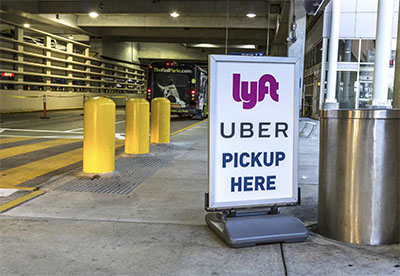WHEN RIDE-HAILING COMPANIES UBER AND LYFT hit the streets in 2011 and 2012, respectively, they signaled a tectonic shift in the way people share transportation. And they have been cutting into taxicab profits ever since.
The on-demand vehicle services work similarly. They’re run through smartphone apps that allow users to, with a few clicks, order a car, input a destination and pay using a credit card or online bank account. The straightforward system revolutionized the ride-hailing experience by eliminating the tiresome process of flagging down a cab, suffering through the confusing fare system and navigating the difficulties of paying the driver.
The user experience is generally superior with Uber and Lyft, too: Drivers might offer water or snacks and the ability to choose your own music, and there is more transparency in terms of fees and routes. Riders also have the ability to rate their drivers and give feedback, designed to help improve the user experience by weeding out drivers who are unsafe, unfriendly or otherwise ill-equipped.
In theory — if not always in practice — the driver experience is better than working for a cab company. Uber and Lyft drivers can set their own hours, use their own vehicles and possibly earn higher wages than if they worked for cab companies. And because the interactions with customers — from getting paid to selecting a route — are all managed by the app, drivers should feel less burdened overall.
Ride-hailing through Uber and Lyft has become so popular that in some urban areas corporations offer credits with the companies in lieu of a corporate car. For more casual uses, the sheer density of Uber and Lyft drivers in many cities means people now commute, shop and head to their favorite bar or restaurant via Uber or Lyft.
Uber and Lyft, both based in San Francisco, enjoyed exponential growth since their inception. The two companies created a billion-dollar industry in just a few years. For its part, Uber now has about 8 million users worldwide and a $69 billion net value in 2017, operating in 83 countries and 674 cities worldwide. In 2016 the company’s drivers gave 2 billion rides around the world. The ride-hailing leader fulfills 40 million rides a month and cornered 77 percent of the U.S. ride-hailing market. In New York the iconic yellow taxi is being replaced by Uber and Lyft cars, which as of 2017 outnumber cabs in the city by a four-to-one margin.

Two tourists in New York look at their phone and wait for a Lyft driver to arrive © BENOIT DAOUST | DREAMSTIME
Lyft, while a smaller company, still holds its own in the market. The company boasts 3 million active monthly users and 1 million rides per day. Lyft passengers took 160 million rides in 2016, and the company operates in 300 cities, all in the United States.
Lyft has a long way to go to catch up to its competitor, but it’s making inroads. Lyft’s gross bookings and the revenue earned by its drivers grew by 25 percent to $1 billion in the second quarter of 2017, up from $800 million in the previous period. That rate makes it a faster-growing company than Uber. Lyft, in 2017, announced plans to expand worldwide and give Uber an even bigger run for its money. Few details have been announced, but insiders expect Lyft to unveil more as 2018 gets underway.
Both companies are investing in self-driving car technology, putting them at the forefront of this new movement. Uber implemented driverless cars first, rolling them out in Pittsburgh and Tempe, Ariz. Later in 2017, Lyft announced a partnership with drive.ai, which specializes in driverless car technology. Lyft says it will implement a pilot program in San Francisco that will offer free rides to select customers in cars that use the technology. Per California law, however, the cars must also have a driver present to act as backup.

Airports even have Lyft and Uber pickup spots. © JONATHAN WEISS | DREAMSTIME
With the continued rise of smartphone usage, it seems both services are set to be a permanent fixture of the transportation landscape. And yet despite their success, the companies have not been without a number of crises and controversies, with Uber taking the lead on that dubious honor.
The app has seen cab drivers protest its inception in Paris, Berlin and London. As a result, it’s been banned altogether in Berlin, and the government rejected its expansion into London.
This year has been especially tough for Uber, with scandal after scandal plaguing the company. In March a video surfaced of company cofounder and then-CEO Travis Kalanick being a jerk to his Uber driver. Then news arose of a legally questionable program the company implemented called Greyball, aimed at avoiding government scrutiny. Further allegations of a misogynistic workplace and incidences of sexual harassment helped lead to Kalanick’s resignation from his CEO position, though he still remains on the Uber board of directors.
Financially questionable practices led to the company burning through capital and consistently operating at a loss despite its growth in revenue. Uber sued the city of Seattle to block a law allowing gig-economy workers — such as Uber’s own drivers — to unionize. The company has also systematically worked to undermine Lyft, even implementing a coordinated effort dubbed Operation SLOG and a program called Hell to track Lyft drivers — all without their knowledge, of course.
Reports surfaced of Uber’s mistreatment of its drivers and the general discontent of its workforce. Its operations team has been in disarray for months as the company tries to salvage its brand in the midst of multiple controversies.
Last year news broke that Uber’s self-driving cars were malfunctioning. Then came a lawsuit from Waymo, a driverless car company under Google parent Alphabet, that Uber conspired to steal and duplicate Google technology in its self-driving cars. New legal woes may arise from the recent disclosure that Uber paid hackers $100,000 to destroy the personal information of 57 million of its riders and drivers the hackers had stolen in 2016, rather than alert authorities and users at the time, as required by law.
With so many issues plaguing Uber, Lyft stood to benefit. The company saw a jump in ridership of around 7 percent between the end of January and March as riders switched allegiances following all that bad press for its competitor. But Lyft drew ire of its own when reports surfaced of the company cutting fares, forcing drivers to spend more time driving, refusing to offer benefits and reporting its wages are higher than they really are.
Uber made significant changes to overcome the deluge of negative coverage and recurring scandals. In response to reports of disgruntled drivers, Uber implemented an in-app tipping component similar to the one currently available on the Lyft app, which has offered tipping since 2012. In several surveys, drivers said they liked driving for Lyft better because of the tipping system, so that small change could go a long way to help keep Uber drivers happy.
Despite struggles, both companies continue growing and remain at the forefront of the transportation industry. It seems Uber and Lyft are here to stay.
Read This Next

Introducing
FX Excursions
FX Excursions offers the chance for once-in-a-lifetime experiences in destinations around the world.
#globility
Insta FeedDaily
May 23, 2025Up Your RV Game with All-Electric Luxury RV, New Gear
If you’re chomping at the bit to head into the wilderness and set up camp, we’re with you. For a dose of luxury, enjoy an off-grid adventure for up to seven days with the new Pebble Flow. With a sleek, aerodynamic futuristic profile, the Pebble Flow also boasts a dual-motor Active Tow Assist System to allow for pulling with an electric vehicle. Features include lightweight composite and sustainable materials; panoramic windows with a 270-degree view; convertible furnishings; and a modern, minimalist design aesthetic. The chef-inspired kitchen, silent HVAC system and spa bathroom provide travel comfort, and nature-inspired colors including Sky, Fern, Poppy and Sand add to the overall sense of serenity. Bonus: The Pebble Flow can sight, align and hitch all on its own, while The Pebble App and dual-motor drivetrain let you maneuver, reverse, park and position with ease.
Sponsored Content
Find Your Perfect Escape with Paradisus by Meliá — More Than Just All-Inclusive
Luxury travel today is about more than just beautiful accommodations — it’s about experiencing the destination. Paradisus by Meliá takes traditional all-inclusive resorts to the next level by offering indulgence with immersion, experiences and authenticity. Each resort is shaped by its location, local flavors and curated Destination Inclusive® experiences that bring you closer to the heart of the destination.
May 2025
May 23, 2025Relax, Rejuvenate and Heal at StolenTime
At the namesake luxury, 5-star all-inclusive resort in Saint Lucia, the concept of “stolen time” used to be reserved for couples escaping to canoodle, reconnect and perhaps rekindle in sumptuous accommodations during a romantic getaway on the lush Caribbean island. But when StolenTime by Rendezvous rebranded in late 2022 to welcome all adult guests and focus more on wellness, the philosophy expanded to encompass self-reflection, personal growth and enrichment. After all, time is our most precious commodity, one that’s finite and too quickly slips through our grasp; we need to find those moments that matter and make them count.
Daily
May 23, 20254 High-Altitude Hotels for Summer Travel
Travelers looking for a summer escape with less crowds and cooler temps should consider a visit to these four hotels in high-altitude destinations.
Sponsored Content
Explore Europe with the Best River Cruise Line this November
Experience Europe from a fresh perspective with AmaWaterways, just awarded Best River Cruise Line by Global Traveler for the third consecutive year. Step aboard, unpack once and embark on a cruise through iconic capital cities and awe-inspiring landscapes. AmaWaterways' ships, which accommodate an average of just 156 guests, offer a spacious yet intimate setting. Throughout your journey, you'll enjoy exquisite farm-to-table dining; unparalleled service; and a variety of included excursions, from city tours for gentle walkers to thrilling bike rides along the rivers.
Daily
May 23, 2025First Zetter Hotel in 10 Years to Open in London’s Bloomsbury Neighborhood
In early 2026, Zetter Hotels opens its first hotel in 10 years in London’s Bloomsbury neighborhood. The Zetter Bloomsbury will bring Georgian charm and elegance to life across its design-forward guestrooms and suites.
Hotel Nice Beau Rivage Review
eFlyer Reviews
May 21, 2025eFlyer News
May 21, 2025Raffles Hotels & Resorts to Debut in Mexico in 2029
Raffles Hotels & Resorts will debut in Mexico with Raffles Estera East Cape Resort & Residences in 2029, marking the hotel brand’s entrance in North America. Set to occupy a stretch of unspoiled beachfront in Los Cabos’ East Cape community, which extends from San José del Cabo to Los Barriles, the resort and residences will feature 60 guestrooms and 46 branded residences in the first development phase.
Sponsored Content
Seoul: Your Next MICE Destination
Seoul has rapidly become a leading global MICE hub, known for its rich culture, advanced technology and strong economy. As the capital of South Korea, it offers a strategic location in East Asia and a booming cultural influence through K-pop, K-movies, Korean cuisine and K-dramas. With its vibrant atmosphere and business-friendly environment, Seoul is increasingly the top choice for MICE organizers and corporate travelers seeking connection and collaboration.
eFlyer Deals
May 21, 2025Celebrity Cruises Launches Limited-Time Sale
Celebrity Cruises’ Spring Sale is a can’t-miss. For travel now until June 2, save up to 75 percent on the second guest and get an additional $400 off per sailing.
ShareThis